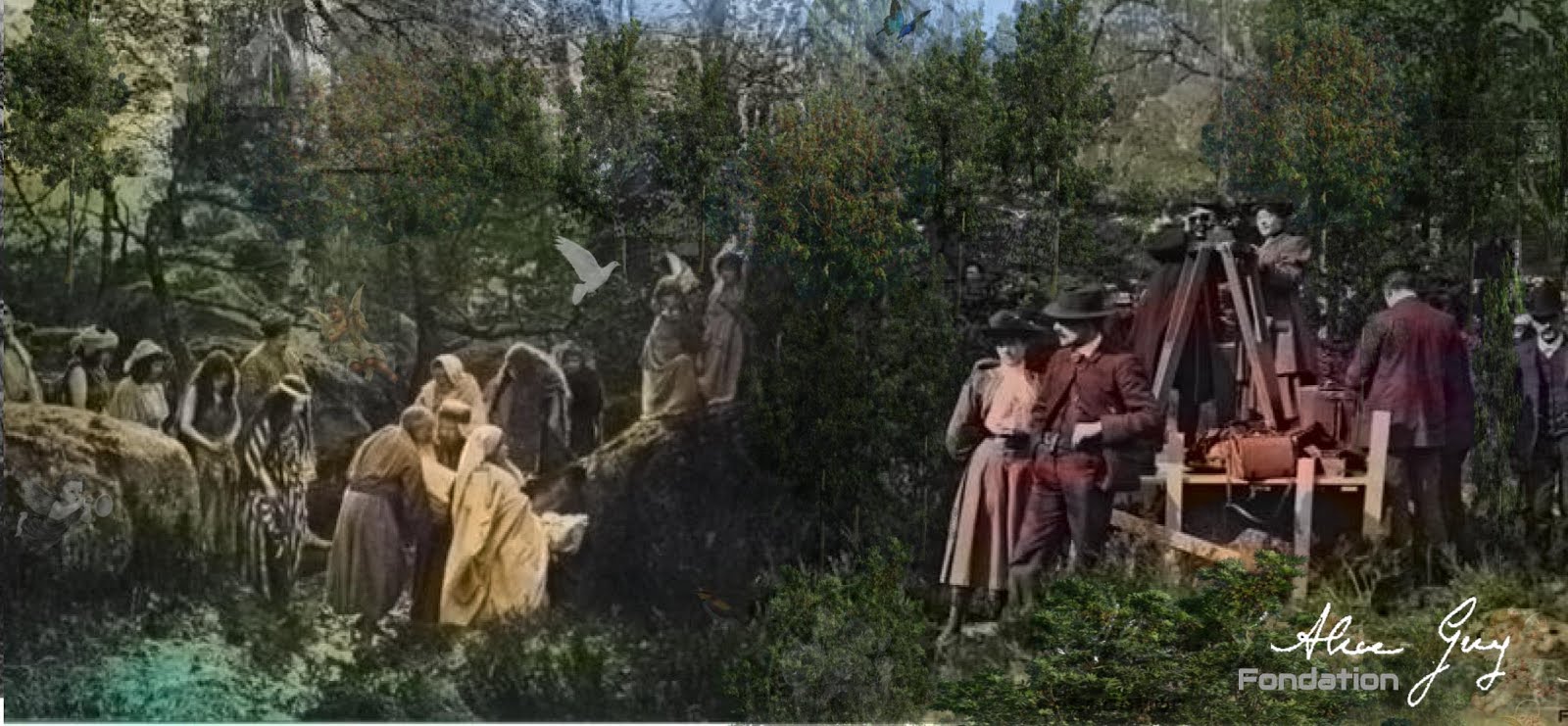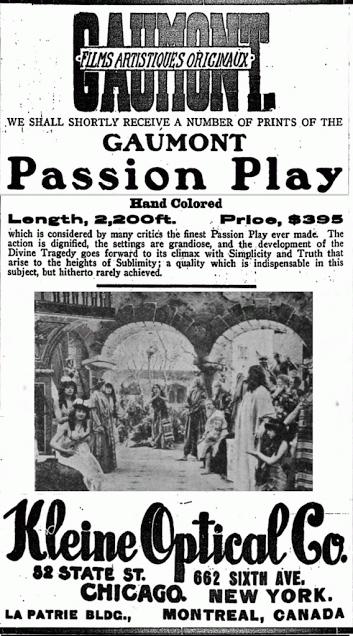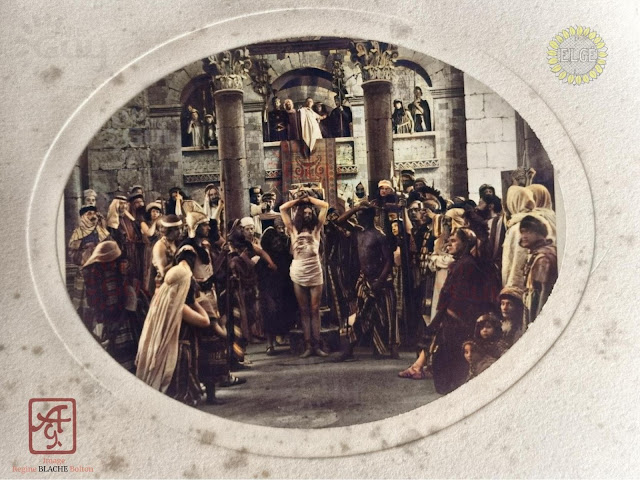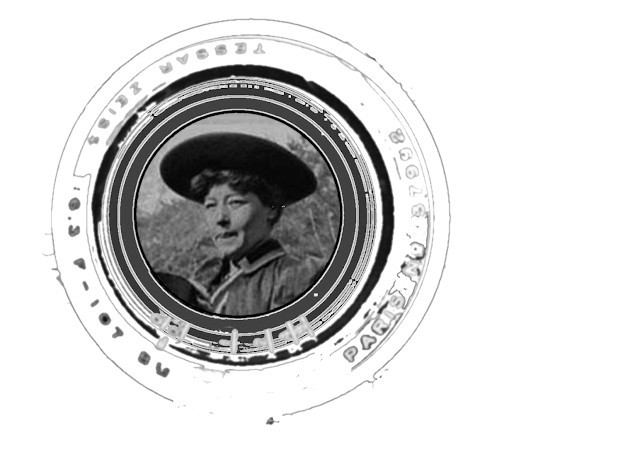jeudi 19 septembre 2019
vendredi 30 août 2019
dimanche 12 août 2018
La vie du Christ Alice Guy ElGe 1906 Photographer: Albert Gilibert
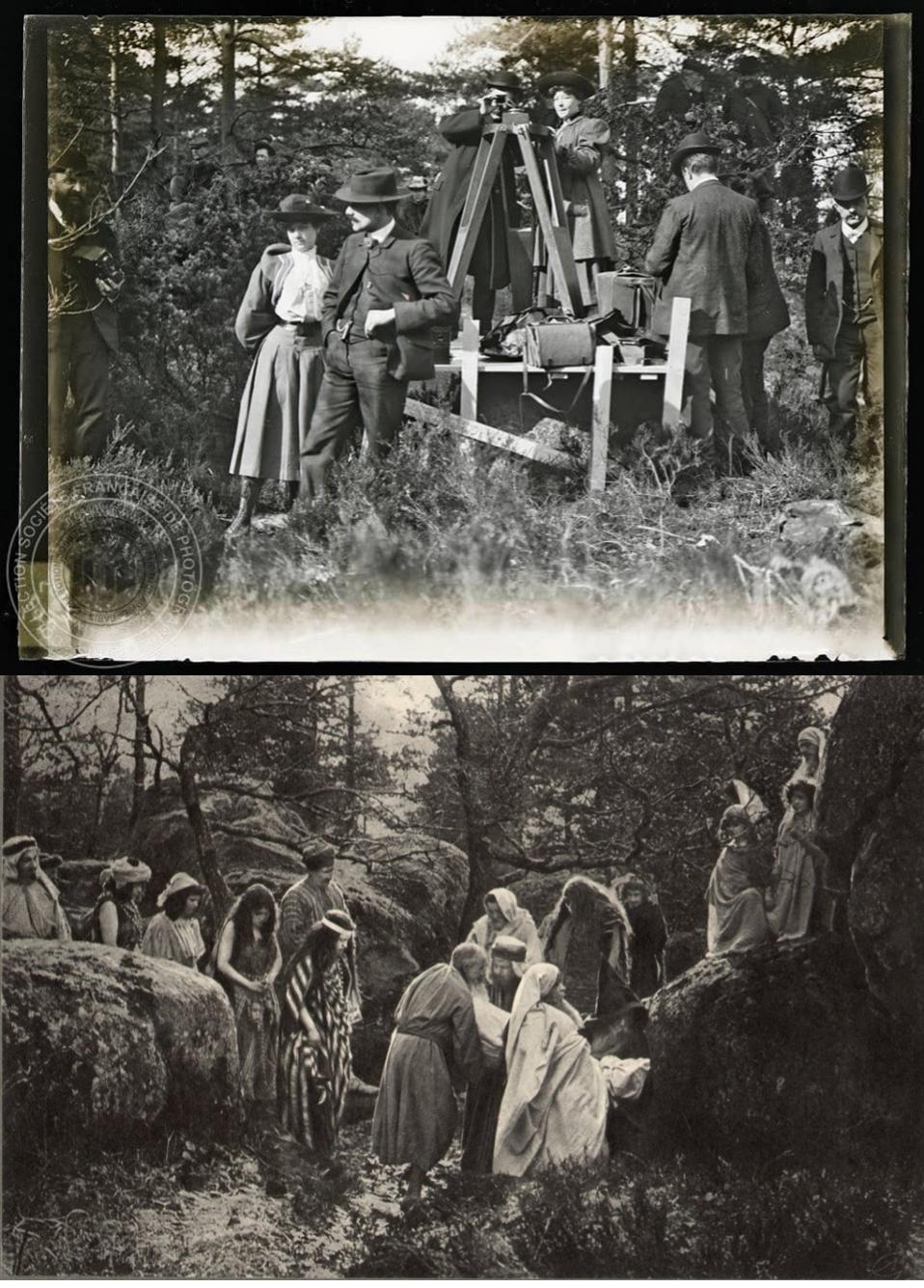 |
| Añadir leyenda |
 |
| La vie du Christ Alice Guy 1906 Photographer: Albert Gilibert |
 |
| La vie du Christ Alice Guy 1906 Photographer: Albert Gilibert |
 |
| La vie du Christ Alice Guy 1906 Photographer: Albert Gilibert |
Alice Guy’s La Vie du Christ: A Feminist Vision of the Christ Tale
By Gwendolyn Audrey Foster.
Alice Guy is a filmmaker whose body of work is still a site of contestation for modern critics; after all these years, her name is nearly unknown. Yet her output was prodigious. Of the nearly four hundred films Guy directed between 1896 and 1920, Guy has two main periods of work as a director: for Leon Gaumont’s studios, where she began her career after breaking out of the secretarial pool in 1896 to become, within a short space of time, the principal director for the studio; and in the United States for her own company, Solax, which flourished for a few brief years after the turn of the century in Fort Lee, New Jersey. Yet much of her work is lost. For a long time, only a handful of Guy’s many films were thought to have survived, among themLes Cambrioleurs (1898), Surprise d’une maison au petit jour (Episode de la Guerre de 1870) (1898), Les Maçons (1905), Le Fils du garde-chasse (1906), Le Noël de monsieur le Curé (1906), and La Course à la saucisse (1907).
Yet Alice Guy is in the forefront of cinema history by any measure, working in sync-sound, hand tinted color, and making films of relatively epic length when the medium was still in its infancy. Indeed, close readings of the films of Alice Guy place her work at the center of cinema history. For the most part, the films of Alice Guy have been overlooked by film historians who incorrectly assume that Guy’s films represent a footnote to film history, rather than being one of the first major bodies of work in narrative cinema. Indeed, as one of the first persons to direct a film with a narrative structure, and thus to direct actors to convey the essence of the narrative through gestures and actions, Alice Guy is one of the originators of filmic acting, both in theory and in practice. Indeed, she is the first real auteur of the cinema.However, in 2009, Gaumont released a shockingly well-preserved DVD of more than sixty of Alice Guy’s films made between 1987 and 1913, including Baignade dans le torrent (1897), Chez le magnétiseur (1898), La bonne absinthe (1899), her remake of her 1896 hit La Fée aux choux, ou la naissance des enfants (1900), Faust and Mephistopheles (1903), The Consequences of Feminism(1906), On the Barricade(1907) and La Vie du Christ(1906), at 33 minutes one of the most ambitious films made up to that point in cinema history, long before D.W. Griffith even stepped behind the camera to direct his first one-reel film, The Adventures of Dollie (1908). But history has not treated Alice Guy kindly, or even fairly; even with the release of the 60 films on this disc, she is still marginalized from most conventional cinema histories, and new articles appear on an almost annual basis “discovering” her for the first time, even as her films go unscreened in film history classes.
Alice Guy was born in Paris in 1873. She was raised in a middle-class family, the youngest of four daughters of a bookseller. Educated at a convent in Switzerland, she was hired as a secretary by Leon Gaumont. It was not very long afterward that she began to take on more duties at the studio. In fact, she would later help her employer build the first Gaumont studio in France. Gaumont experimented with moving cameras and projectors, eventually building a 35mm (standard theatrical gauge) camera combined with a projector. In 1896, Alice Guy directed The Cabbage Patch, or La Fée aux choux, one of the world’s first films with a plot. Best described as a picture postcard that springs to life, the film tells the story of how children are “born” in a cabbage patch; the French version of babies being delivered by a stork in American culture. Alice Guy shot the film with the help of her friend Yvonne Mugnier-Serand, in the garden of Gaumont’s house, with a few backdrops for sets, and the help of some friends as actors. The film displayed the French style of light humor, and an appreciation for magic and the fantastic, similar to that of Georges Méliès and other early French film directors. (The Cabbage Patchwas remade by Guy in 1900 when the original prints from 1896 wore out. The remake has been the cause of much confusion by film historians.)
Among the numerous works that Alice Guy directed during her early years, one of her major accomplishments was the production of La Vie du Christ (1906). The film was an ambitious spectacle that utilized lavish budgets, large crews, and hundreds of extras, in settings designed and executed by Henry Ménessier. Alice Guy managed to skillfully incorporate the use of extras to give added depth to her work, the same way that the American director D. W. Griffith did many years later in Birth of a Nation(1915) and Intolerance (1916). Indeed, for its period, La Vie du Christ was considered an exceptionally lavish production, on which Guy spared no expense to bring her vision to the screen.After her first narrative film, Guy began to make films with well-known French opera singers and clowns. She tackled many different genres: fairy-tales, fantasy films, horror films, comedies, and trick-films, making dozens of films for Gaumont. For example, in her 1904 film, The First Cigarette, or La Prèmiere cigarette, Alice Guy was already using close-ups to heighten dramatic effects. She also included “reaction” shots, that is, shots showing actors reacting to one another. In another short film, Pierrot’s Christmas (1900), Alice Guy used novel cinematic devices such as “masking” and “double exposure.” In short, Alice Guy was one of the originators of filmic grammar, syntax and structure, as well as one of the first directors to conceive of the idea of modern film acting, instructing theatrically trained performers on how to effectively address the camera. In this, she was very much against the stylized, pantomime approach to direction that she perceived in her nascent contemporaries of the era. In instructing her actors, Alice Guy asked them to behave as “naturally” as possible, that is, to incorporate the performative strategies of everyday social intercourse into the infant fabric of filmic narrative signification. She intuitively began blending nineteenth century theatrical acting styles with more “naturalist” twentieth century modes of cinematic performance.
In addition to the film’s formalist concerns, Guy’s version of the life of Christ betrays a feminist perspective towards the subject, which blends spectacle and realism in an unprecedented manner. I view this film within a theoretical and historical perspective, which highlights Alice Guy and her role in the development of a cinematic style that embraces and problematizes notions of “realism” and “artifice” in gendered performativity. Like many other silent films of the era, Guy readily mixes staged studio settings with natural location shooting, a practice which continues to the present day. However, the extreme stylization of Guy’s vision in La Vie du Christ effectively creates an alternative universe, in which the protagonists of the film seem enshrined by each of the carefully framed compositions. Indeed, Guy’s film is almost a moving painting, in which the prescient naturalism of the performers seems at times strikingly removed from the constructed settings which dominate most of the production.Alice Guy’s La Vie du Christ was released in Paris in April, 1906, and subsequently released with newly translated intertitles in May, 1907 in the United States. Seen today, the film seems brief, running 2,164 35mm feet, or slightly more than an half an hour in length. It is divided, like Jean-Luc Godard’s much later films, into 25 separate scenes, from the arrival in Bethlehem, in which Joseph and Mary are turned away from the stable (this sequence runs 131 35mm feet in length), to the burial of Christ, (which is the longest sequence in the film, at 147 35mm feet). Nevertheless, by the standards of the period, La Vie du Christ was both ambitious and lavish in production, as well as epic in running time, in an era in which most films lasted only a few minutes. In each of the sequences of La Vie du Christ, Guy seeks to formalize and ritualize the life and death of Christ as a series of naturalistic, humanist sequences, told through gesture and silence alone, in which the stations of Christ’s life can be segmented into a series of tableaux.
In La Vie du Christ, women are foregrounded as central characters and witnesses to the spectacle of Christ’s birth. Christ himself is feminized and eroticized. In general, performances are unlike those of other films of the same period. Characters are suffused with familiarity, carnality and corporeality. Sets combine highly artificial indoor tableaux vivantes with outdoor scenes and neorealist staging. This skillful use of diegetic space is accented by widely differing acting styles. Scenes of family life are intercut with scenes of pageantry, yet the naturalistic acting in La Vie du Christdisdains theatrical performativity and artifice. In this departure from recognized classics of the period, Guy refigures the performance of gender in the Christ parable, emphasizing and privileging women and children as active participants who perform in a spectacle that combines theatricality with an almost neorealist and decidedly feminist vision.
Looking at the film, one is struck by the manner in which Guy combines the elements of “natural” or “real” with “artificial” and “theatrical.” Obviously, Guy expects her audience to accept the casual mixing of outdoor photography and natural lighting with beautifully rendered and highly stylized interior set designs, for example. From a twenty-first century perspective, the variation of design and performance styles in the film is jarring, but nevertheless compelling. Perhaps this accounts, to some extent, for the paucity of scholarship or interest in Alice Guy’s life of Christ. But it is important to remember that Alice Guy, like many other silent film pioneers, straddled the aesthetics of the old world and the new, and the public and private spheres. Guy’s ability to combine these two disparate spheres of performance is indicative of a cultural moment that is an essential point of transition in understanding the cultural changes between the nineteenth and early twentieth century.Artists and filmmakers whose work dares to step out of the boundaries of critical schools and artificially defined aesthetic codes often find themselves categorically removed from the center of discursive fields of inquiry. One example of just such an artist is Jacques Joseph Tissot, a nineteenth century painter who is celebrated for his Victorian renderings of elegant women, but who is casually derided for his extensive, highly successful, and influential Bible illustrations. These Bible illustrations, published in the highly popular and influential Tissot Bible, were the inspiration behind Alice Guy’s lengthy filmic portrayal of the life of Christ, known alternatively as La Vie du Christ, La Passion, and La Passion du Christ. Tissot’s Bible and Alice Guy’s La Vie du Christ share a preoccupation with performing the life of Christ in a style that combines realism, spiritualism and literalism that perhaps seems crude, violent or graphic compared to other films of the period. The flogging of Christ by the centurions, for example, is presented in a near-documentary manner, despite the conscious artificiality of the settings and costumes. This unusual juxtaposition of the real and the constructed is emblematic of Guy’s directorial style in La Vie du Christ.Tissot’s Bible was perfectly acceptable to his nineteenth century audience precisely because it accurately performed the hybridity that viewers were experiencing in the nineteenth century culture, which was split between science and religion. As Christopher Wood notes of Tissot’s scene of the Passion, “although it may seem in dubious taste today, it is precisely this brand of vulgarity, realism and mysticism that appealed to the Catholic faithful of the 1890s” (1986: 150). Tissot himself underwent a spiritual conversion during the late nineteenth century Catholic revival in France. His work displays its cultural origins in a mixture of Catholicism and spiritualism that was deeply concerned with realism and authenticity and oddly enough its opposite, spirituality and the sublime. Just as Tissot traveled to Egypt, in order to copy the “original sites” of the New Testament, Alice Guy used the Tissot Bible to capture a sense of the “real” and/or “authentic” life of Christ. As Guy remembers in her memoirs:
“I had long wanted to make a film about the fine drama of the Passion. At the 1900 Exposition [Universelle in Paris], Tissot had published a very beautiful Bible illustrated after the sketches he had made in the Holy Land. It was ideal documentation, for decors, costumes and even local customs.” (Guy 1986: 42)
Indeed, Guy borrowed and appropriated Tissot’s compositions. She found outdoor exteriors in the forest of Fontainebleau that mimicked Tissot’s sketches. She also instructed Henri Ménessier to construct twenty-five sets after Tissot’s Bible. She employed hundreds of extras, and with her assistant, Victorin Jasset (who was later falsely credited as the director), Alice Guy began to film her lavish production of the life of Christ for the Gaumont company.
Alice Guy designed shots that use deep screen space within the frame. Actors enter scenes from the reverse and from the angle of the camera itself, effectively breaking with the traditional theatrical fourth wall. Although the camera moves little and adheres to the style of proscenium arch directing (popularized in the early twentieth century), the development of multi-planed spaces that are populated by hundreds of onlookers and participants is impressive. The sets highlight the use of forced perspectives, reminiscent of illuminated medieval manuscripts. Actions often take place at the borders of the frame, to further the sense of extra-diegetic space. The shot compositions are often unusually complex and involve staged designs that center around columns, arches, and multiple-level platforms with extraordinarily complex designs. The only use of a close-up in the film is a tight close up of the face of Christ, again emphasizing the corporeality of the subject.The staged tableaux vivantscenes in La Vie du Christ are, as Judith Butler notes in another context, “performative in the sense that the essence or identity that they otherwise purport to express are fabrications manufactured and sustained through corporeal signs” (1990: 136). The corporeal signs of Jesus as a living being are stressed by the use of scores of children, obviously non-actors, who pervade the entire spectacle. The baby Jesus is just that, a baby brought onto the set and surrounded by onlookers. Jesus and Mary are distinctively unkempt, human; they reek of sensuality and corporeality. Women and children predominate in the composition. The viewer is startled by the degree to which Alice Guy portrays the spectacle of the birth and life of Christ as a family affair, with children present at all times. Children and women witness and take part in events, as do Africans. Guy goes to great effort to use and fill space with humanity, and humanity is not defined here as white male.
La Vie du Christ freely juxtaposes images that partake of the supernatural with scenes of the mundane. In this manner, the nature of the film articulates the nineteenth century Christian opinion that seeing is believing, or, as Michel de Certeau writes, “the ancient postulate of the invisibility of the real has been replaced by the postulation of its invisibility” (1984: 187). The scenes of the life of Christ are performed in an arena of the real and the sublime. The design of the film demonstrates de Certeau’s postulate that “the fabrication of simulacra provides the means of producing believers” (1984: 186). The fabrication of the simulacra of Jesus Christ is a central preoccupation of the film, but the simulacra, the copy without an imaginable original, is here a complicated matter: here Jesus is both human and ordinary and sublime and extraordinary as are the events in his life. Perhaps this is one of the most significant achievements of the film. Theologians have long struggled with the question of how to emphasize the mundane corporeality of Christ and convincingly portray the fantastic and miraculous life of Christ. La Vie du Christ as spectacle is productive, or, as Miranda Joseph notes, “performance is just as well able to bear value (use, exchange, surplus, status) and to produce subjects and social formations as any material commodity, arguably better able” (1998: 53).
The intrinsic value of Alice Guy’s La Vie du Christ is not only important because of its ability to corporealize Jesus Christ but, I’d argue, it is one of the few times that the life of Christ is infused with the life of women and children as spectators, actors and performers of the spectacle itself, as angels, or as common women. Guy’s images explode with light and movement, as hundreds of extras flow through the frames ofLa Vie du Christ on a variety of simultaneous planes of action. The large number of women and children further encourage audience identification with the film, and open up the finished production to a wider viewing audience.
Guy’s feminism may seem unusual to the late twentieth century viewer. The film is populated by women and girls as angels, much in keeping with proscribed notions of femininity, yet these angels carry along the plot; they are not devoid of subjectivity. Perhaps La Vie du Christ may be viewed as a site of transformative value in its depiction of performing women. As Lynda Hart notes,Instead of being centered on the figure of Christ, with all the other performers drifting into the background, Guy constructs a living world in which all the participants are equally important to the gaze of the camera. Guy populates the symbolic imagination of her Biblical illustrations with a female gaze that includes the manufacture of a life of Christ that is significantly feminist in nature and takes place in the feminized, privatized home-like sphere. Women and children are numerous and ever-present in Guy’s interpretation of Christ’s life. One could easily view this as Guy’s apparent response to the absence of women and children in then-contemporary cinema, and the stereotypical renderings of women and children in the Victorian era. In contrast to the idealization of the feminine and infant forms in other films of the period, Guy’s women and children are fully human; they look at the camera, directly address the viewer, and engage in interactions between themselves that are entirely incidental to the film’s central narrative. In addition, Guy’s performers range across a wide variety of ethnic backgrounds, which constitutes a further departure from Victorian pictorial signification.
“One response to the impossibility of the feminine taking a place within the symbolic has been an effort to recover, or postulate, a prediscursive body, a critical effort to free the female body from its overdeterminations as a body saturated with sex, site of pleasure for (an)other, subjected and devoid of subjectivity. (1993: 5)
Thus, Alice Guy’s women move away from overdeterminism, though they are certainly not devoid of subjectivity. The subjectivity of women and children is rendered in a striking design of female enunciation. Indeed, this life of Christ is told through the eyes of the girl angels who guide us through the story. Each tableauxbegins with a title card held up by three girls dressed as angels. This is a life of Christ told not only from the point of view of these angels, but a tale that is performed andenacted by women and children throughout the entire narrative. In the scene of “Le Sommeil de Jesus” (in the American version, “The Infant Jesus’ Sleep”), there is only one male adult to be found. The baby Jesus is surrounded by eight girl angels and one woman figure (presumably Mary).
These girl angels are reminiscent of the Angel of the House of the nineteenth century. They are not passive, fainting, impossibly ethereal presences, but instead diligently hard-working musicians in an unusual rendering of the common icon of the sleeping baby Jesus. These young women look directly at the viewer, as if to invite her/him into the manufactured spectacle of realism, in a display of the redemptive possibilities of performance and decorative film space. Between the real and the fantastic, the angels invite the participant to witness an event that is both sublime and familial, earthy and unearthly.
In the tableaux of the Garden of Olives, or “Au Jardin des Oliviers,” we find another manifestation of the female gaze of Alice Guy, as she works to place women in the symbolic logocentric arena. Here the outdoor setting is brilliantly illuminated in natural light. Nature itself is presented as a site of redemption, but, significantly, a young girl, dressed as an angel, presides over the life of Christ. Here, the collision of artifice, theatricality, and the obviously constructed filmic corporeal female meets the space of real and “authentic” nature, perhaps best illustrating Alfred Jarry’s unusual pronouncement that “decor is a hybrid, neither natural nor artificial” (1996: 210). In her construction of the film’s decor, Alice Guy renders a “natural” outdoor setting as a hybridized, artificial space.
Indeed, Alice Guy was so successful in her melding of the real and the fantastic in La Vie du Christ that the film was later credited to other directors such as Victorin Jasset, who was in actuality the assistant director. Guy herself straddled the world of the Victorian Angel of the House and the newly emerging New Woman, and she seems to have been able to draw, in life, from these seemingly incongruent models of feminine comportment. She has been unfairly dismissed by some critics as a non-feminist, apparently because her practical, direct feminism does not fit categorically within prescribed late twentieth century models of feminist discourse. In performing her own style of feminism, Guy, like many other women of her time, was able to embody both the archetype of the New Woman, and also of the Angel of the House, paving the way for the modern woman of the twenty-first century.In the fluid simulation of events of Christ’s corporeality, Alice Guy values the painted backdrop as much as she does the natural “backdrop” of the forests of Fontainebleau. Similarly, Guy values the supernatural girl “Angels” as much as she does the other numerous “real” women and children in the film. Indeed, the sheer number of women in the twenty-five scenes of La Vie du Christ seem designed to convey the feminization of the life of Christ. Similarly, Christ’s crucifixion is attended by scores of women and children. When Christ rises from the dead, the spectacle of the resurrection is seemingly facilitated by several young girls, who apparently will the event through the power of their gaze. As Guy recounts in her memoirs, this scene was also a technical challenge, involving multiple superimpositions to achieve the desired effect: “The Angel presenting the chalice to our Lord, the climb up Calgary, the Entombment, all these scenes succeeded. Jesus rising from the sepulcher was one of our best superimpositions” (Guy 1986: 43).
The home of the photoplay is the home of the performing woman in La Vie du Christ, which itself is a “homey” version of the life of Christ. It beckons to the gaze of the female audience and invites her to make herself at home in the symbolic arena of the celestial, even as it represents the celestial as decidedly familial and home-like. Thus, Guy’s film offers a useful counterpoint to such patriarchally dominated narratives as Cecil B. De Mille’s The Ten Commandments (both the silent 1923 version, and the 1956 remake) or Nicholas Ray’s King of Kings (1961). In re-envisioning the Christ tale as a fable in which the re-gendered Christ is seen as the savior of all humanity, not just a male-defined and dominated cultural and pictorial landscape.In fact, Alice Guy transcended these proscribed binaries. She continues to transcend them in her work, leaving a legacy of filmmaking that began with the dawn of cinema and continued until the early teens. As an early French filmmaker, and later an early American filmmaker, she was able to skillfully combine the real and the fantastic. In her now famous essay, “A Woman’s Place in Photoplay Production,” reprinted in her memoirs, we can view her as a performing self that draws together the Angel of the House and the New Woman. It is the same woman who is now credited with having directed some hundreds of films who uses the Angel to sweep the New Woman in the door of the motion picture industry in a wonderful example of female rhetoric: “A woman’s magic touch is immediately recognized in a real home. Is it not just as recognizable in the home of the characters of a photoplay?” (Guy 1986: 128).
An earlier version of this essay originally appeared in the journal Film Criticism. A good biographical source on Alice Guy is the 1995 documentary The Lost Garden: The Life and Cinema of Alice Guy-Blaché directed by Marquise Lepage. The film includes footage of interviews with Guy and her family members as well as film historians. It also features a plethora of previously unseen clips from her films in all genres, many of them sound and color tinted. Also see the Gaumont Treasures, Vol IDVD box set from Kino (2009). Alongside the work of Louis Feuillade and Léonce Perret, the box contains La vie du Christ as well as many of the previously “lost” films of Alice Guy. Many are handtinted and some are sound films recorded on wax cylinder. The Consequences of Feminism, 1906 is a hilarious send up of feminism itself and a must see. The set does not include the original La Fée au choux, but it does include the remake of 1900.
jeudi 15 mars 2018
mercredi 5 juillet 2017
Inscription à :
Articles (Atom)
